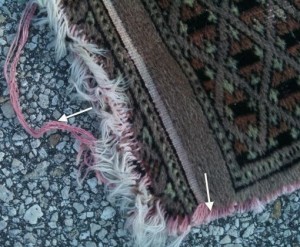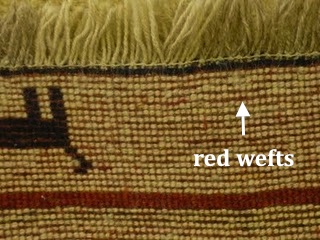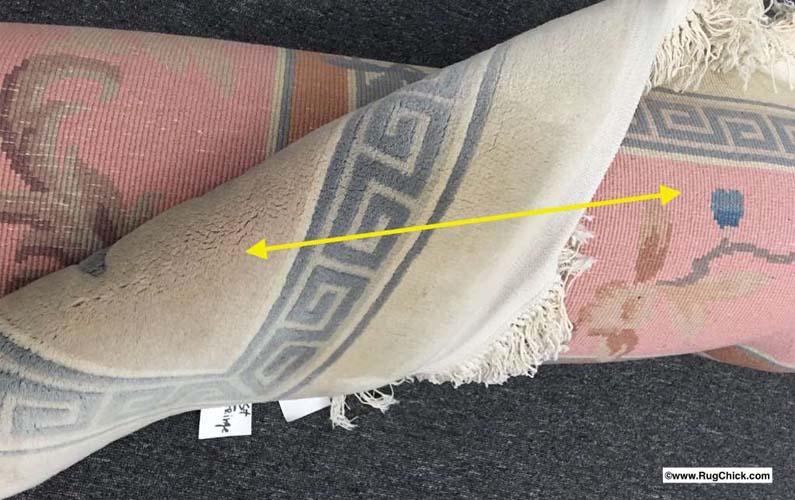Hidden danger – bleeding rug wefts.
Every professional rug cleaner knows how to test a rug to see if the dyes are colorfast or not. At least they should know how to. Especially since a good percentage of new rugs today have dye colorfastness “issues.”
I walk through the steps in my post on dye testing, and the video on how to do it is down below.
Click here How To: Dye Test
I mention in the video to dye test the front AND the back – why?
Because you are not just testing the fuzzy face fibers to see if they may bleed during cleaning, you also want to see what the INSIDE foundation fibers may do when wet.
You remember the loom of a hand woven rug, and how every knot is twisted around two warps threads, with weft threads used to hold the rows of face fiber knots in place? Here’s a loom photo to remind you

It can take months, even years, to weave a large rug.

Diagram of cotton warps and wefts with wool symmetrical knots.

See white horizontal wefts peeking through the back.
When the warps and wefts are white, or a very light color, there are no worries. But sometimes the wefts are NOT white. They might be blue, gray, black, red, purple – and they may bleed on you.
Here’s a hand woven rug with light gray wefts (will not bleed) next to a machine-made rug, which has knots wrapped around the wefts so you do not see them at all. (By the way, this is how you identify the difference between hand woven and machine woven rugs – knots wrapped around the warps are hand woven, around the wefts are machine – we will touch on that another time in more depth.)

Hand woven next to machine woven.

Loose weft threads have pulled away from this rug.

Pink line where it should be white.
Normally these pink wefts are not a problem with washing. In fact most rugs are not a problem under regular circumstances. These conditions though of long term wet exposure from pets made them bleed. If this had been a rug with no pets around, and washed regularly, that pink would never be visible on this rug from the front.
But some rugs are in fact a problem even under normal circumstances. They have DARK wefts. Here’s a potential problem:

Red wefts on a new Gabbeh.
So you make sure to test the BACK of the rug for colorfastness. If it tests fine – you can clean stress-free.
You also need to pay special attention to any existing spills (especially pet accidents) to identify existing dye migration that might wick up and be visible in the cleaning. The dye may test strong, but in these damaged areas (by the pets) the dye will release and bleed out – that is what happens when pet urine damages rugs over time.
Many rugs are washed before being exported for sale. It’s the ones with cut corners that present the problems today… problems that can averted through thorough inspection of the front and back of each rug, and dye testing both sides, BEFORE the cleaning begins.
Simply making your wash quicker, and using the proper dye stabilizing solution will keep the lurking danger from rearing its ugly head. But the worst thing to happen will be when you test the top side for colorfastness, it tests fine, and then you wash as normal and some UNEXPECTED color rises up from the base of the rug to scare the heck out of you because you did not test the back.
Seeing rising lines of red, blue, or black dye in stripes all over a rug appear as you clean is a frightening experience. One that is entirely avoidable with the right pre-wash inspection skills.
Happy cleaning – and HAPPY New Year!
– Lisa
P.S. Those of you who are professional cleaners, my training schedule is coming out soon, so if you are interested in working with me this year be sure to opt in to the Rug Disasters Report in the right column of this blog. Then you will get notified as soon as openings are available. Looking forward to working with you!










